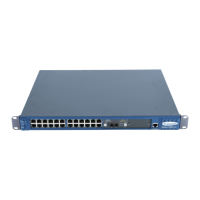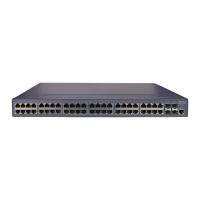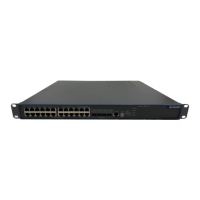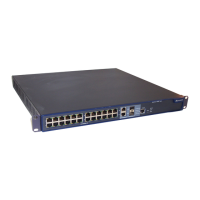Command Manual – Routing Protocol
Quidway S3900 Series Ethernet Switches-Release 1510
Chapter 1 Static Route Configuration
Commands
Huawei Technologies Proprietary
1-9
Description
Use the display ip routing-table ip-prefix command to display the routes that filtered
through a specific ip-prefix list.
This command is mainly used to track and display the results of route policy. It displays
and only displays the routes that filtered through the ip-prefix list you specified.
If the specified ip-prefix list does not exist, with the verbose argument provided, this
command displays the verbose information of all active and inactive routes; without the
verbose argument provided, this command display the summary of active routes only.
Example
# Display the summary of the active route that filtered through ip-prefix list abc2, which
permits the routes with a prefix of 10.1.1.0 and a mask length ranging 24 to 32.
[Quidway] ip ip-prefix abc2 permit 10.1.1.0 24 less-equal 32
[Quidway] display ip routing-table ip-prefix abc2
Routes matched by ip-prefix abc2:
Summary count: 2
Destination/Mask Protocol Pre Cost Nexthop Interface
10.1.1.0/24 DIRECT 0 0 10.1.1.2 Vlan-interface1
10.1.1.2/32 DIRECT 0 0 127.0.0.1 InLoopBack0
For detailed description of the output information, see Table 1-1.
# Display the verbose information of the active and inactive routes that filtered through
ip-prefix list abc2.
[Quidway] display ip routing-table ip-prefix abc2 verbose
Routes matched by ip-prefix abc2:
+ = Active Route, - = Last Active, # = Both * = Next hop in use
Summary count: 2
**Destination: 10.1.1.0 Mask: 255.255.255.0
Protocol: #DIRECT Preference: 0
*NextHop: 10.1.1.2 Interface: 10.1.1.2(Vlan-interface1)
Vlinkindex: 0
State: <Int ActiveU Retain Unicast>
Age: 3:23:44 Cost: 0/0 Tag: 0
**Destination: 10.1.1.2 Mask: 255.255.255.255
Protocol: #DIRECT Preference: 0
*NextHop: 127.0.0.1 Interface: 127.0.0.1(InLoopBack0)
Vlinkindex: 0
State: <NoAdvise Int ActiveU Retain Gateway Unicast>
Age: 3:23:44 Cost: 0/0 Tag: 0
For detailed description of the output information, see Table 1-2.

